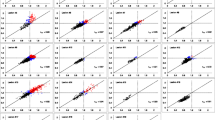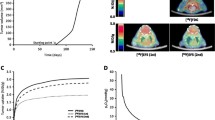Abstract
In vivo demonstration of hypoxia is of significance for tumour patient management. Fluorine-18 fluoromisonidazole ([18F]FMISO) is a proven hypoxie imaging agent. We developed an [18F]FMISO tumour to muscle retention ratio (TMRR) for the detection of tumour hypoxia in nasopharyngeal carcinoma (NPC). Data were acquired by positron emission tomography (PET) of the nasopharynx and neck after intravenous injection of 370 MBq of [18F]FMISO. Two imaging protocols were adopted: a long protocol for comprehensive dynamic information and a short protocol for a simple, clinically convenient imaging procedure. Tomograms were reconstructed and evaluated visually. ROI analysis on the basis of time-activity curve evaluation was performed to calculate the TMRR of NPC or cervical nodal metastases (CNMs) in relation to the suboccipital muscles at 2 h. The calculation of the TMRR was exactly the same for both the long and the short protocol as two 30-min composite frames had been created immediately after intravenous injection and 2 h after injection of [18F]FMISO in the long protocol. The normal tissue to muscle retention ratio (NTMRR) was derived similarly from the normal nasopharynx. The data of 12 controls and 24 patients with NPC were analysed. The long protocol was used in 15 patients, and the short protocol in nine. In controls, the mean NTMRR±1 SD was 0.96±0.14. The mean TMRRs for NPC and CNMs were 2.56±1.50 and 1.35±0.51, respectively; these values were significantly higher than the mean NTMRR for normal controls (P<0.005 in each case). At the retention threshold value of 1.24, tumour hypoxia occurred in 100% of the primary lesions of NPC and 58% of CNMs. The TMRR for undifferentiated carcinoma was significantly lower than that for non-keratinized carcinoma (P<0.05). The [18F]FMISO TMRR is a simple and clinically useful index for detecting tumour hypoxia in NPC.
Similar content being viewed by others
References
Mottram JC. Factors of importance in the radiosensitivity of tumors.Br J Radiol 1936; 9: 606–614.
Powers WE, Tolmach LJ. A multi-component x-ray survival curve for mouse lymphosarcoma cells irradiated in vivo.Nature 1963; 197: 710–711.
Moulder JE, Rockwell S. Hypoxic fractions of solid tumors: experimental techniques, methods of analysis and a survey of existing data.Int J Radiat Oncol Biol Phys 1984; 10: 695–712.
Gatenby RA, Kessler HB, Rosenblum SJ, et al. Oxygen distribution in squamous cell carcinoma metastases and its relationship to outcome of radiation therapy.Int J Radiat Oncol Biol Phys 1988; 14: 831–838.
Cater DB, Silver LA. Quantitative measurements of oxygen tension in normal tissues and in the tumors of patients before and after radiotherapy.Acta Radiol 1960; 53: 233–256.
Hockel M, Knoop C, Schlenger K, et al. Intratumoral PO2 histography as predictive assay in advanced cancer of the uterine cervix. In: Vaupel P et al., eds.Oxygen transport to tissue XV. New York: Plenum Press; 1994: 445–450.
Nunn A, Linder K, Strauss HW. Nitroimidazoles and imaging hypoxia: review article.Eur J Nucl Med 1995; 22: 265–280.
Webster LT. Drugs used in chemotherapy of protozoal infections. In: Gilman AG, Rall TW, Nies AS, Taylor P, eds.The pharmacological basis of therapeutics, 8th edn. New York: Pergamon Press; 1990; 1002–1004.
Edwards DI. Nitroimidazole drugs — action and resistance mechanisms. I. Mechanisms of action.J Antimicrob Chemother 1993; 31: 9–20.
Brown JM. Hypoxic cell radiosensitisers: Where next?Int J Radiat Oncol Biol Phys 1989; 16: 987–993.
Chapman JD, Franko AJ, Sharplin J. A marker for hypoxic cells in tumours with potential clinical applicability.Br J Cancer 1981; 43: 546–550.
Martin GV, Caldwell JH, Rasey JS, Grunbaum Z, Cerqueira M, Krohn KA. Enhanced binding of the hypoxic cell marker [18F]fluoromisonidazole in ischemic myocardium.J Nucl Med 1989; 30: 194–201.
Rasey JS, Grunbaum Z, Magee S, et al. Characterization of radiolabeled fluoromisonidazole as a probe for hypoxic cells.Radiat Res 1987; 111: 292–304.
Rasey JS, Koh W, Grierson JR, Grunbaum Z, Krohn KA. Radiolabeled fluoromisonidazole as in imaging agent for tumor hypoxia.Int J Radiat Oncol Biol Phys 1989; 17: 985–991.
Grierson JR, Link JM, Mathis CA, Rasey IS, Krohn KA. A radiosynthesis of fluorine-18 fluoromisonidazole.J Nucl Med 1989; 30: 343–350.
Grunbaum Z, Freauff SJ, Krohn KA, et al. Synthesis and characterization of congeners of misonidazole for imaging hypoxia.J Nucl Med 1987; 28: 68–75.
Rasey JS, Grunbaum Z, Shankland EG, et al. Imaging tumor hypoxia with [F-18]fluoromisonidazole [abstract]. J Nucl Med 1987; 28: 594.
Rasey JS, Nelson NJ, Chin L, et al. Characterization of the binding of labeled fluoromisonidazole in cells in vitro.Radiat Res 1990; 122: 301–308.
Koh WJ, Rasey JS, Evans ML, et al. Imaging of hypoxia in human tumors with [F-18]fluoromisonidazole.Int J Radiat Oncol Biol Phys 1991; 22: 199–212.
Valk PE, Mathis CA, Prados MD, et al. Hypoxia in human gliomas: demonstration by PET with fluorine-l8-fluoromisonidazole.J Nucl Med 1992; 33: 2133–2137.
American Joint Committee on Cancer Manual for Staging Cancer, 4th edn. Philadelphia: J.B. Lippincott; 1992; 37.
Cherif A, Yang DJ, Tansey W, et al. Rapid synthesis of 3[18F]fluoro-l-(2′-nitro-l′-imidazolyl)-2-propanol [(18F]fluoro-misonidazole).Pharm Res 1994; 11: 466–469.
Cater DB. Oxygen tension in neoplastic tissues.Tumori 1964; 50: 435–444.
Varghese AJ, Whitmore GF. Binding to cellular macromolecules as a possible mechanism for the cytotoxicity in misonidazole.Cancer Res 1980; 40: 2165–2169.
Jerabek PA, Patrick TB, Kilbourn MR, Dischino DD, Welch MJ. Synthesis and biodistribution of F-18-labeled fluoronitroimidazoles: potential markers of hypoxic tissue.Appl Radiat Isot 1986; 37: 599–605.
Koh WJ, Rasey JS, Grierson JR, et al. Hypoxia imaging of tumors using [F-18] fluoromisonidazole.J Nucl Med 1989; 30: 789.
Koh WJ, Rasey JS, Evans ML, et al. Imaging human tumor hypoxia using [F-18] fluoromisonidazole.J Nucl Med 1991; 32: 955.
Koh WJ, Rasey JS, Grierson JR, et al. Hypoxia imaging of tumors using [1F-18] fluoromisonidazole [abstract].J Nucl Med 1989; 30: 789.
Chapman JD. Measurement of tumor hypoxia by invasive and non-invasive procedures: a review of recent clinical studies.Radiother Oncol 1991; 20 Suppl l: 13–19.
Author information
Authors and Affiliations
Rights and permissions
About this article
Cite this article
Yeh, SH., Liu, RS., Wu, LC. et al. Fluorine-18 fluoromisonidazole tumour to muscle retention ratio for the detection of hypoxia in nasopharyngeal carcinoma. Eur J Nucl Med 23, 1378–1383 (1996). https://doi.org/10.1007/BF01367595
Received:
Revised:
Issue Date:
DOI: https://doi.org/10.1007/BF01367595




